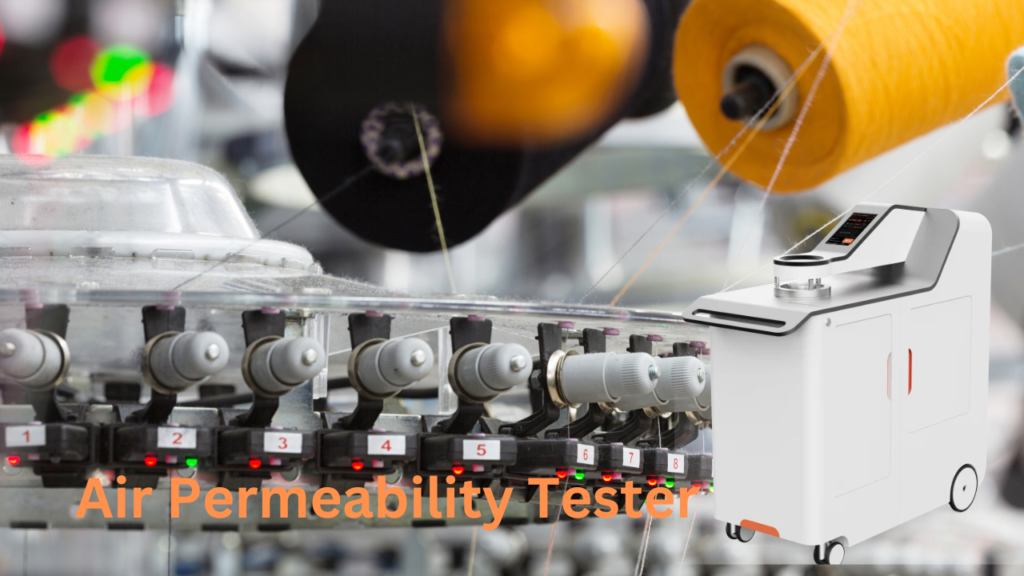Air permeability tester opens up this realm of opportunities, granting profound insights into fibers and various manufacturing sectors. Have you ever wondered how a simple airflow through a material shows us essential aspects and whether the material is suitable for different applications?
In our guide, we explore the complex world of the air permeability test for fabric, a process that we dissect step by step to provide you with the knowledge and expertise needed to examine this material analysis aspect.
Understanding Air Permeability Tester
Air permeability testing machine determination is one of the most important steps of material analysis, enabling researchers to gather valuable knowledge about the relationships between pressure and various materials. This testing method allows the scientists of the R&D department to measure air passage through a subject, thereby enabling them to characterize the material’s breathability, porosity, and overall quality.
Importance of Air Permeability Testing
It was the porosity coefficient that brought it into the open airpore./s permeability. Textiles are still full of air channels and porous no matter their style.
Therefore, air permeability tester changes the properties of the textiles and the air layer, which can be achieved by moisture management, air droplet properties, and thermal regulation.
Process of Air Permeability Testing
Air permeability tester for textiles plays a significant role in analyzing materials, giving necessary information on the behavior and performance of various materials. Air permeability testing is not the exclusive domain of any one kind of industry – it is essential in the materials of Alzheimer’s, medical product development, or any other field bearing on materials.
Step 1: Prepare the Sample
Before starting, the sample must be well prepared for air permeability testing. However, the process involves conditioning the sample to the same temperature and humidity.
Ensure that the sample has not been stained and is free from any wrinkles or thick folds that would hinder the accuracy of the test.
Step 2: Set Up the Testing Equipment
To perform air permeability tests, one will need an air permeability tester, such as the widely used ASTM D737 or JIS L 1096 apparatus. Assemble the equipment following the supplier’s instructions. Moreover, the testing area has to be devoid of any obstructions that might cause airflow restriction problems.
Step 3: Create the Testing Condition
To measure air permeability accurately, one must first create a stable testing environment. This comprises setting up the pressure difference needed at the sample and guaranteeing that the air volume over it is always the same. Use the method prescribed by the standard for your particular use, or check your test standard.
Step 4: Conduct the Test
Put the conditioned model into the air permeability test equipment properly. Be sure that it covers the entire testing area with no overlap. Switch on the airflow and let it find balance. Then, read the difference in pressure between the sample and the airflow rate through it.
Step 5: Calculate and Interpret the Results
When the test has finished, air permeability should also be determined using a proper formula for the test method, in addition to the square permeability meter area of the specimen and the pressure change.
Step 6: Analyze and Adjust
The Shirley air permeability tester data can be a means of characterizing the passage of air, and water vapor permeability and determining other relevant properties of the materials. Make sure to compare the data that you have with the test specs or your specified benchmark if they are already set.
In case of need, make necessary changes in the material or the test conditions to make the material work more efficiently. Finally, retest and verify the new material’s performance.
FAQs
Q: What is the significance of air permeability testing in the textile industry?
In the textile industry, where air permeability is an essential parameter, it is the main tool for diagnosing breathability and comfort. By winning the challenge of measuring air entry into the fabric, the textile industry can conclude what the fabric is best used for.
Q: How does air permeability affect the performance of materials?
Materials’ air permeability, which shows how they allow air to pass through them, directly affects their functional performance. This is especially true for breathable products such as coats or medical suits.
Conclusion
Understanding air permeability is not just a test at its most basic level, it is rather an overview of the main online data of the characteristics of the project, which provides information on the different stages involved as well.
From the sample collection and installation of equipment to conduct tests and interpretation of the data, it can be revealed how much air can penetrate the material, which is its porousness, the extent of openings, and overall quality.
This guide is a summary of the basic aspects of performing an air permeability test, and if you want to succeed with the said technology, it can be a good source to have satisfactory results of the highest product performance and functionality level.


